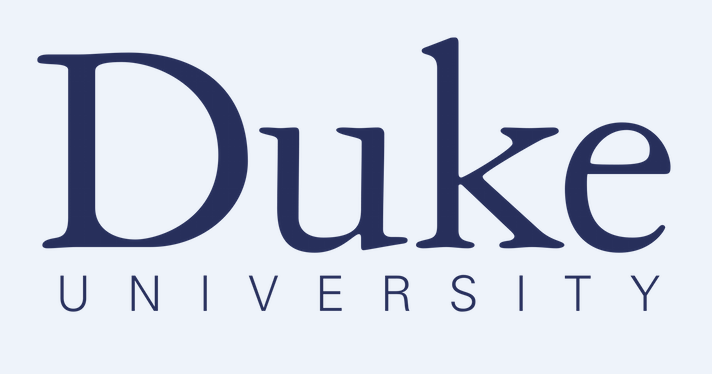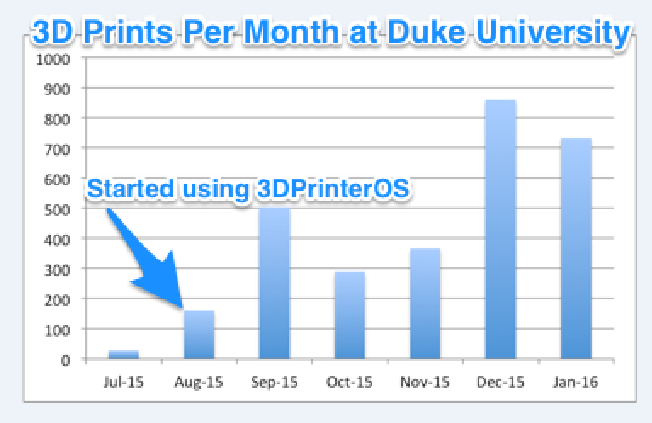Duke University Case Study on 3D Printing Labs Leads Them to Streamlined Management with 3DPrinterOS
 3D printing labs seem to have a way of growing and growing, directly in line with the ever expanding enthusiasm levels of innovating students and faculty. At Duke University, their lab has grown from one single Printrbot Simple Metal 3D printer to more than 35—and all in just a couple of years.
3D printing labs seem to have a way of growing and growing, directly in line with the ever expanding enthusiasm levels of innovating students and faculty. At Duke University, their lab has grown from one single Printrbot Simple Metal 3D printer to more than 35—and all in just a couple of years.
With 250 students having access to the printers at various places on campus, there’s a lot of opportunity for innovation, and administration and faculty plan to see that continue to grow. How to manage what they’ve begun as well as expanding became a question though, which led to a comprehensive case study by the team at Duke to see how they could make the most of their growing technology and continue to see it work best for the bright minds producing 3D prints on campus.
Chip Bobbert, digital media engineer and emerging media technologist at Duke, has been part of the program since it began. He sees amazing 3D printed products coming from their students, and with such success emanating from the program, it was important to stay on the right track as their inventory of machines grew.
“There’s a new phenomenon happening where students are meeting and forming their own businesses. They are building their own products. They are working through rapid prototyping processes,” explains Bobbert. “No longer is it ‘I’m going to go work at NASA.’ It’s ‘I’m going to start my own company.’”
 The program has been very popular from the start, and eye-opening for all involved as they realized its incredible value to so many—prompting them to work on the case study and ensuing program, especially as they realized how many individuals in their midst had been working in 3D for years but were without an efficient way to bring their concepts to fruition.
The program has been very popular from the start, and eye-opening for all involved as they realized its incredible value to so many—prompting them to work on the case study and ensuing program, especially as they realized how many individuals in their midst had been working in 3D for years but were without an efficient way to bring their concepts to fruition.
“Traditional machining requires years and years to master the CNC technology, and tools and die makers may spend their entire career figuring out how to make some of the things we can make with essentially the simplicity of clicking file and print,” said Bobbert.
As part of their case study, Bobbert and his team closely examined how other universities were setting up and handling their 3D printing labs and practices. While again, the equipment and the enthusiasm was there, lack of organization in labs was widespread. Their findings are not surprising, as this is a common theme in schools that become very excited about the technology and offering it to their students but often a framework—much needed—is not provided at all, much less other aspects like education regarding how to actually use the machines, or training regarding maintenance.
“We went out and looked at other colleges and toured labs trying to really understand what was working for them and what wasn’t. Where schools struggled was in providing an easy way to make machines available and manage that process,” said Bobbert.
 In studying other organizations—as well as their own needs—Bobbert and the team from Duke realized what they needed was a good organizational solution, eliminating issues like the need to have a PC tethered to each 3D printer. With 3DPrinterOS, they found that they could provide a cloud infrastructure and total management for their substantially growing network.
In studying other organizations—as well as their own needs—Bobbert and the team from Duke realized what they needed was a good organizational solution, eliminating issues like the need to have a PC tethered to each 3D printer. With 3DPrinterOS, they found that they could provide a cloud infrastructure and total management for their substantially growing network.
Anyone with university credentials from Duke is now able to use the lab. They can upload files and then 3D print on any of the 35 printers which are spread out among various campus locations, along with using apps to print remotely. This means they can be productive with their time while a print is ongoing, and can actually watch its progress via live video streamed from cameras which are installed on the machines.
Bobbert points out that the 3DPrinterOS recording mechanism is an extremely valuable feature as well. While crucial in helping with user accountability, it is a very positive tool in helping everyone see how many hours are being logged and whether there is a need for more hardware.
“We had over 4800 hours of printing by 250+ students across 2500+ print jobs last semester alone. We were able to track individual users, machines and print jobs across the entire network via 3DPrinterOS reporting features and we used that data to justify adding an additional 22 Ultimaker 3D printers to meet the growing demands of our student body and faculty,” said Bobbert.
 With tracking and reporting data easily at hand via 3DPrinterOS, they were also able to track activity patterns from the students and create customized reports detailing reasons for items like print job cancellations. That type of data helps them understand how the program is working and through analysis, they can figure out what improvements might need to made for better success in 3D printing for all of the machines in their network.
With tracking and reporting data easily at hand via 3DPrinterOS, they were also able to track activity patterns from the students and create customized reports detailing reasons for items like print job cancellations. That type of data helps them understand how the program is working and through analysis, they can figure out what improvements might need to made for better success in 3D printing for all of the machines in their network.
3DPrinterOS caters to the educational system, and their goal is to see that students are thriving and innovating in 3D printing. Their program organizes workflow and takes all the guesswork out of whether or not it’s time to add more equipment to a lab. Without having to associate one computer with each printer, the whole process is streamlined and managed from one central place, with a monitoring dashboard to organize prints on multiple machines.
We’ve followed 3DPrinterOS as they continue to bring organization to schools and businesses, with a growing worldwide network, innovative partnerships, and a new private cloud platform for businesses which was just unveiled at CES 2016 in Las Vegas. As they continue to build on the success of their public cloud launched in 2015, 3D printing labs around the world are experiencing the benefits of streamlined management. What do you think of the management options offered by 3DPrinterOS? Tell us in the Duke 3D Printing Case Study forum over at 3DPB.com.
Subscribe to Our Email Newsletter
Stay up-to-date on all the latest news from the 3D printing industry and receive information and offers from third party vendors.
You May Also Like
Gorilla Sports GE’s First 3D Printed Titanium Cast
How do you help a gorilla with a broken arm? Sounds like the start of a bad joke a zookeeper might tell, but it’s an actual dilemma recently faced by...
Nylon 3D Printed Parts Made More Functional with Coatings & Colors
Parts 3D printed from polyamide (PA, Nylon) 12 using powder bed fusion (PBF) are a mainstay in the additive manufacturing (AM) industry. While post-finishing processes have improved the porosity of...
$25M to Back Sintavia’s Largest Expansion of Metal 3D Printing Capacity Since 2019
Sintavia, the digital manufacturing company specializing in mission-critical parts for strategic sectors, announced a $25 million investment to increase its production capacity, the largest expansion to its operations since 2019....
Velo3D Initiates Public Offering in a Bid to Strengthen Financial Foundations and Drive Future Growth
Velo3D (NYSE: VLD) has been among a number of publicly traded 3D printing firms that have attempted to weather the current macroeconomic climate. After posting a challenging financial report for 2023,...































